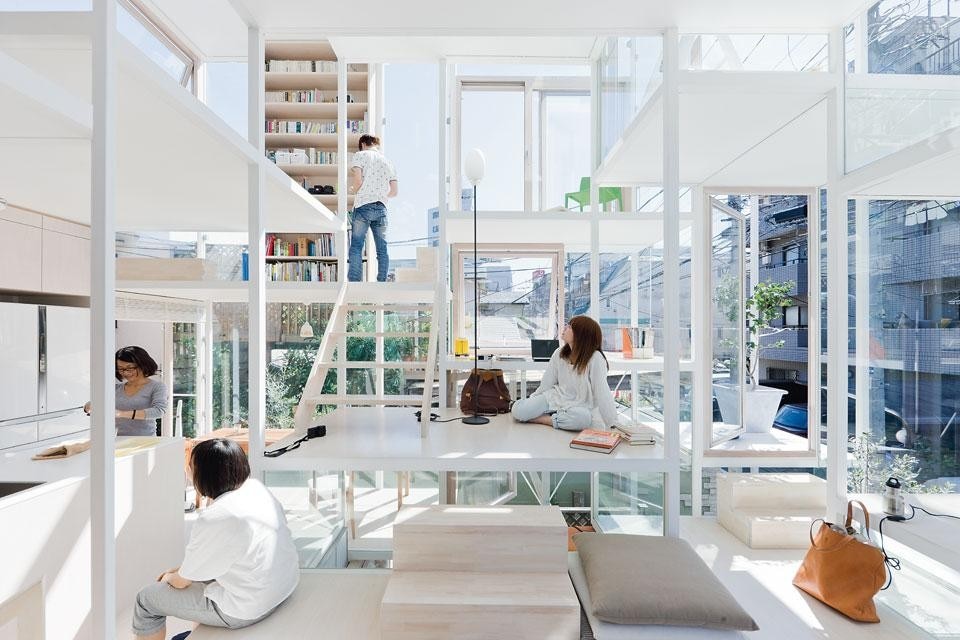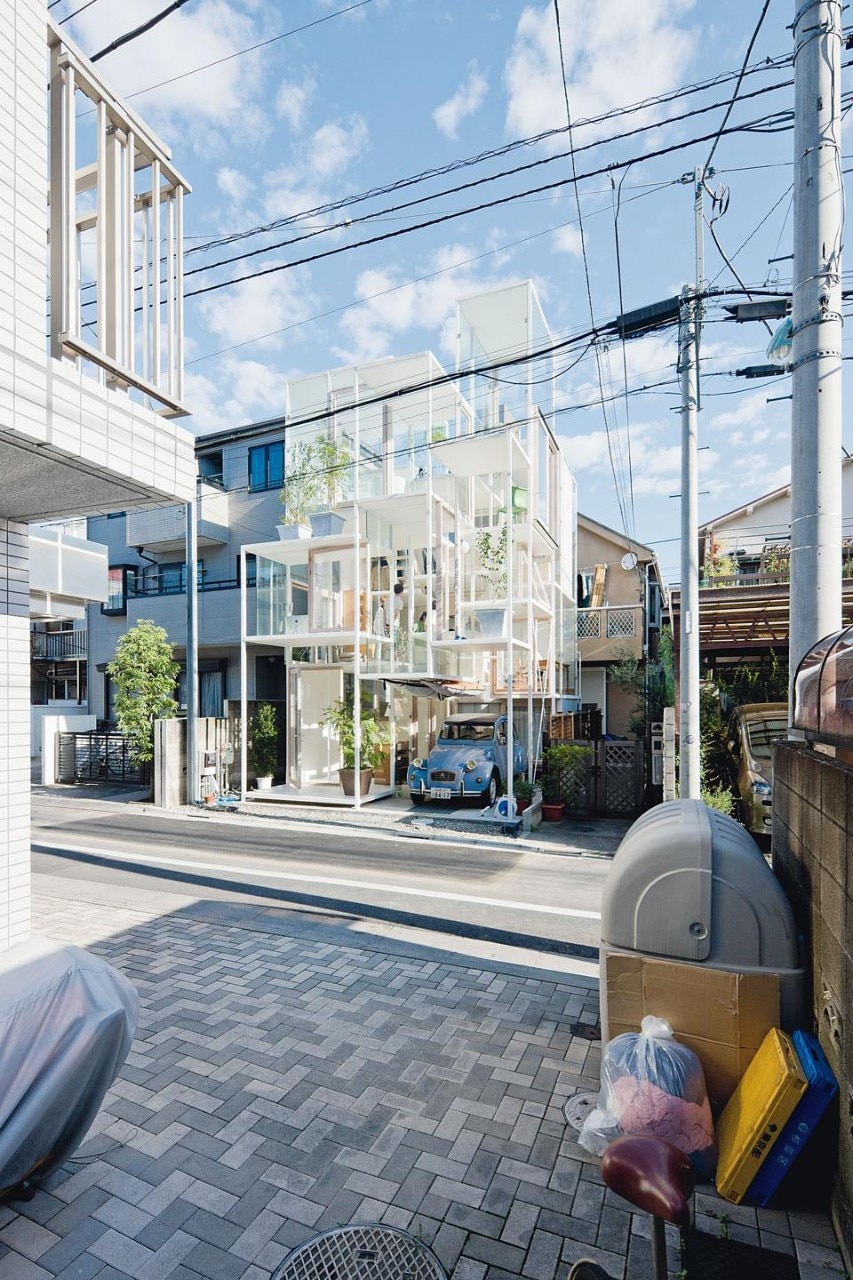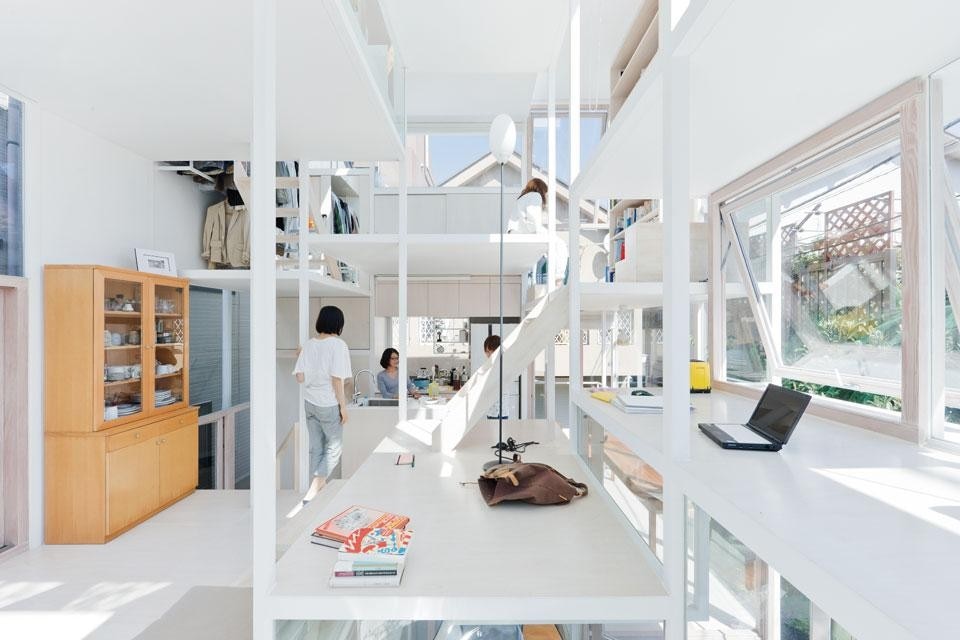Fujimoto's NA House appears to be the most fully realised example along his obsessive path of trying to create an entirely inhabitable contoured environment. This characteristic is evident in many of his works: from the pavilion of wood logs in Kumamoto (Final Wooden House or Log House) to House H, and to the conceptual maquette for Primitive Future Houses, developed in 2001 and presented at Kazuyo Sejima's invitation at the 2010 Venice Biennale. The building is based on a thin, split-level steel frame and represents a fully realised version of a home without stairs.(In truth, there is still a group of steps, which has been treated as a piece of "furniture" that can be moved about and repositioned elsewhere, effectively creating the illusion of multiple interior pathways). As a result, every horizontal plane becomes a generic surface. Without a specifically defined function, they can be used as a desk, shelf, bed, chair, etc., extolling the Japanese custom of sitting and sleeping on the floor in a manner that is so pervasive and clear that, while requiring no lengthy description, gives free reign to the imagination.
All of these projects, but with a greater intensity in the two domestic structures, represent proposals for addressing basic spatial needs, the bare minimum needed for the occupants, yet are indifferent to their surroundings. Transparency and visual continuity are traits shared by these buildings in which facades are non-existent and floor-to-ceiling windows and curtains reign supreme. The fact that no special attention has been given to climate controls, and that both of the domestic examples make use of simple air conditioners, confirms the impression that these houses are abstract, or better, render their context abstract. Is this exhibitionist indifference a result of their verticality? A negative response would be suggested by a comparison with the extremely vertical home-studio of Atelier Bow-Wow—the result of careful observation of its surroundings, in which cladding and windows are arranged so as not to conflict with neighbouring buildings and to maximise the few views available in the dense city blocks of downtown Tokyo. Rather, the Atelier Bow-Wow example shows how these buildings, in particular the domestic ones, are representative statements about the programme and intended to be understood as genuine radical manifestos.

Above: Interior view of the single-volume house. The NA House has an all-steel frame construction in which glazed surfaces and cladding have been mounted without frames. Only doors and windows have wooden frames.
The kind of "extreme living" present in such projects is likely to be accompanied by a number of "tricks" for getting around the limitations imposed by building codes and safety regulations, yet staying within legal boundaries, even if barely. Frequently used in Japanese buildings, these boundary-pushing techniques are permitted in private homes thanks to regulations that shift the sole responsibility for the project from the designer to the owners upon final acceptance. At this point, it would be interesting to compare our two domestic examples with the famous Roof House by Tezuka, where the architects inclined the roof-top terrace slightly so that it would be considered a proper "roof", allowing them to avoid having to install parapets while respecting the law. We shall skirt the issue for the sake of the architects and owners, and readers can form their own opinion about whether the placement of vases and parapets are up to code, or whether certain windows placed near property lines facing adjacent buildings are shatterproof.

Filled with design ploys, these projects present themselves as simple and essential structures.

Design: Sou Fujimoto
Design Team: Takahiro Hata, Keisuke Kiri, Masaki Iwata
Structural Engineering: Jun Sato Structural Engineering
Construction Supervision: HEISEI construction
Built area: 66.03 m.
Design: 01.2007–01.2010
Construction phase: 01.2010—04.2011




